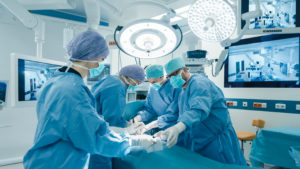Surgery is usually the first step in treating testicular cancer.
Testicular cancer is a very treatable form of cancer. Surgery for testicular cancer is usually a first-line treatment. At Urology Austin, once a physician diagnoses testicular cancer, they develop a treatment plan that takes certain factors into account, such as the stage of the cancer and the patient‘s serum tumor marker levels.
Surgery for testicular cancer: Radical inguinal orchiectomy
In almost every circumstance, a radical inguinal orchiectomy is the first surgery for testicular cancer, even for patients whose cancer has spread. During this surgical procedure, the surgeon removes the entire testicle (or testicles).
Surgery for testicular cancer is performed using general, local or spinal anesthesia. Your Urology Austin surgeon will take precautions to help ensure that no cancer cells from a tumor spread into your blood stream or into the surgical site. One way this is accomplished is to tie off the lymph and blood vessels found in the spermatic cord. After taking these precautions, the surgeon makes an incision into the groin area and removes the testicle(s) directly from the scrotum.
Once the type of testicular cancer is known, further surgery, chemotherapy, or radiation will be offered depending on the tumor type. With this information the urologist will create the proper treatment plan for you after surgery. A typical radical inguinal orchiectomy takes between 20 to 40 minutes to perform, and almost all patients will go home the day of surgery.
Surgery for testicular cancer: Retroperitoneal lymph node dissection (RPLND)
Some patients will require a retroperitoneal lymph node dissection. This surgery for testicular cancer may be done during the radical inguinal orchiectomy or it may be done as a separate surgery. This is a complicated surgery in which lymph nodes are removed from the abdominal area for further evaluation.
The surgery is either done with a traditional abdominal incision, or it may be done using a minimally-invasive technique through small abdominal incisions. RPLND is a major surgery. Patients who need this surgery for testicular cancer will be thoroughly informed about the risks and expected recovery period.
What happens after surgery?
After surgery for testicular cancer, some patients may need no other treatment. Others may need additional treatment, such as chemotherapy or radiation. This will depend on the type of cancer found, and if it as spread. Over time, patients will be closely monitored for cancer recurrence. Further testing will include imaging and blood work.
When patients choose Urology Austin to treat their testicular cancer, they can rely on our team of experts. Contact us to schedule an appointment.

